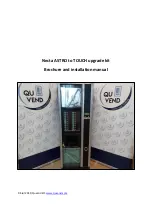
Comco Inc.
vii
Issue Date: July 2016
Working with an Electrical Device
The electrical hazards associated with the MicroBlaster are minimal, since all
primary electrical components are inside the primary housing. However, the
operator should take precautions that apply to any electrical device that has a
power cord that plugs into an electrical outlet. These precautions include:
√
Verify the proper operating voltage on the MicroBlaster by
checking the nameplate located on the back of the unit.
√
Before plugging the power cord into an electrical outlet, examine it
for evidence of damage such as cracked, worn, or torn insulation;
exposure of bare wires; or bent tines on the plug.
√
Ensure that the machine is never operated near water or while it is
wet.
√
Always verify that the power switch is in the OFF position when
the machine is not in use for long periods of time.
When working inside the MicroBlaster housing, there is the possibility of electrical
shock. To minimize this hazard, Comco recommends the following:
√
Unplug t
he unit from facility power any time the machine’s cover
will be removed.
√
Do not operate the MicroBlaster with its cover removed.
√
Keep the interior of the MicroBlaster clean of dust, powder, and
any foreign object or substance that could conduct electricity.
CAUTION:
Some abrasive powders are conductive and
may present a hazard if allowed to
accumulate inside the machine.
Working with the Abrasive Media
The MicroBlaster uses several types of abrasive media that should not be
inhaled or ingested in large quantities or maintained in prolonged contact with the
skin. When working with the abrasive media, Comco recommends the following:
√
Do not direct the abrasive blast on bare skin or face/eyes.
√
A workstation and dust collector
must
be used in conjunction with
the MicroBlaster. If you must blast outside a workstation, a full
face mask and oxygen supplied respirator and hand protection are
required per NIOSH (National Institute for Occupational Safety
and Health).
√
Handling operations such as repackaging or refilling of the
abrasive media should only be performed in well-ventilated areas
and with proper care to minimize dust in the eyes or breathing
passages. Always use a dust respirator for dust protection when
exposed to dust clouds. The 3M respirator #8710 is NIOSH/MSHA
approved for these types of abrasive handling operations.








































